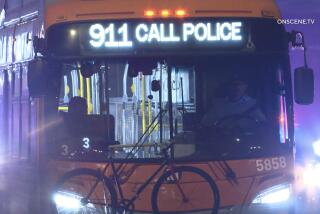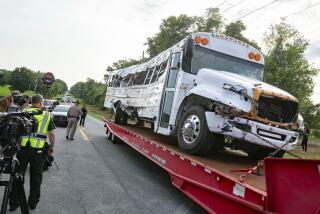Transit Writer Is Real Cone-Killer in His Bus Debut
The other day I drove a transit bus for the first time at the Orange County Transportation Authority practice course in Garden Grove. For about an hour, I felt like Ralph Kramden, but it wasn’t any honeymoon.
I managed to turn a training session into the transit equivalent of Death Race 2000. Barrels flew everywhere. Red plastic cones perished one after another beneath my lurching coach. Spectators stood their distance. Instructors winced.
“Yep, you hit all the pivot cones just like they were dogs,” said Sue White, a veteran bus driver who talked me through my first skills test, a tight slalom run that demands precise handling.
I even trapped an OCTA administrator in the front door of my coach just before we started. Like a knucklehead, I closed it on her before she could get out. Had she been a fare-paying member of the public, I’d have been in more trouble than I already was. OCTA strives to maintain good customer relations.
At least I adjusted the driver’s seat properly.
Operating a 40-foot, 20-ton transit bus isn’t easy. It requires good depth perception, hand-eye coordination, the ability to multi-task, and a strong sense of where the vehicle is in relation to everything else around it.
I learned this the hard way on a long-standing dare from Art Leahy, OCTA’s executive officer, who was a bus driver in traffic-clogged Los Angeles before ascending the heights of management. I finally decided to accept the challenge after thinking about it for a couple of years. As one of the paper’s transportation writers, I thought here was a chance for a little on-the-job training.
The timing for my transit baptism could not have been better. OCTA drivers, executives and board members are practicing at the Garden Grove bus base for the agency’s 32nd Annual Bus Roadeo on Saturday. It’s a driving contest for authority employees. Winners go on to regional and national competitions.
Last year’s champion in the board-member category, Denis R. Bilodeau, also offered to ride along with me to make sure I kept my hands on the wheel and my eyes on the road. Bilodeau likes to boast to his transit colleagues that he is the king and won’t relinquish his crown easily.
OCTA let me drive one of its mainstays -- a big, white 77-passenger New Flyer with orange and blue stripes. Fortunately, only three riders were aboard during my maiden voyage -- White, Bilodeau and Ted Nguyen, OCTA’s spokesman.
The goal was to thread my transit behemoth through 11 closely spaced obstacles marked by rows of cones, tennis balls and barrels. Each test is worth 50 points. A perfect score is 575, including points for delivering a smooth ride.
Professional drivers must complete the course in under seven minutes -- a requirement that was waived in my case, and with good reason.
The slalom, which was the first test, did not go well. Despite White’s coaching, I hit four cones and missed the last gate. My score: 0. The guffaws, snickers and “oh-no’s” from Bilodeau and Nguyen were merciless, especially when one of the slalom’s 11 marking cones turned up missing. We found it under the bus.
The backing test did not go much better. Not being used to sitting ahead of the front wheels, I started my turn too late while backing from the right into a rectangle of markers. Also, my eyes kept fumbling for the correct side-mirror to use. OCTA buses have three mirrors on each side, all with different perspectives.
I ended up hitting four cones, which reduced my score from 50 to 10 for the event. It went so poorly that no one suggested that I try backing in from the left side as called for in the rules.
More cones fell as I entered the offset lanes -- a test that requires drivers to jog their buses from left to right within a short distance. My bus lurched and dipped repeatedly as I applied too much pressure to the sensitive power brakes. Any points for smoothness of ride went right out the exhaust pipe.
The 90-degree right turn went well, but I lost 20 points when I hit two cones during a sharp left turn. But I recovered somewhat by successfully pulling into two simulated bus stops with the help of Dan Gonzales, a 20-year veteran who replaced White as my coach for the latter part of the course.
When driving into a bus stop, keep the curb in the lower inside corner of the driver’s side windshield, Gonzales told me. The bus should line up well and make it comfortable for passengers to board.
Coach operators often use parts of their buses or landmarks, such as poles or benches, as sights or reference points to help them judge distances and position their buses.
“It’s all about approach,” Gonzales said. “You have to get comfortable with the vehicle.”
Next came two diminishing clearance tests. In the first, the wheels on the right side of the bus must pass through a line of tennis balls that narrows at the far end. It’s a difficult trick. I had no clue how to aim the bus. Even with Gonzales’s help, I knocked a couple of tennis balls out of alignment.
For the second clearance test, I had to accelerate the bus to 20 mph and drive through a lane marked by plastic barrels. Again, the width of the lane narrowed toward the far end.
I heard a thud, thud, thud, thud in quick succession. My bus had hit four barrels on the right side. One ended up in a maintenance bay several yards away. Had those been cars on the street, OCTA would have faced some major liability.
Once clear of the barrels, I had to stop my bus as close as I could to a single cone that marked the end of the course. The little pylon disappeared below the windshield as I closed in, but I still managed to stop within a foot of it.
“Not bad,” Gonzales said.
But my time was an appalling 25 minutes, almost four times slower than that required of OCTA bus drivers.
Getting through the course took considerable focus and concentration. I couldn’t imagine doing this on the street. Real coach operators have to maneuver through heavy traffic, help the public, maintain order, call out streets for passengers, stay on schedule and obey a host OCTA regulations. None of that was required of me.
“Good drivers become one with the bus,” said Gonzales, who has trained winning Roadeo teams seven years in a row. “They develop a sense of where objects are and a feel for the bus, both its length and width. You’ve got to be alert and trust no one’s driving except your own.”
With Gonzales as my coach, my second and final run went much better. I knocked down half as many cones as my first hop and my time improved substantially.
I was so pleased with myself my thoughts turned to one of OCTA’s big, articulated buses, which pivot in the middle to help the operator turn sharply. The authority deploys the 60-foot coaches on its busiest routes.
Maybe next year. For now, I’ll leave the driving to the professionals.







